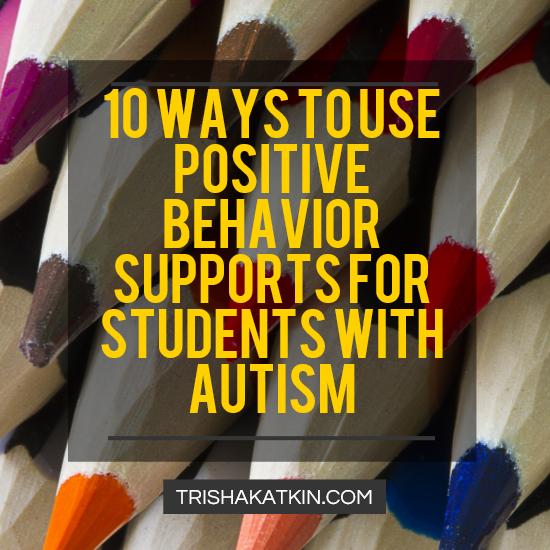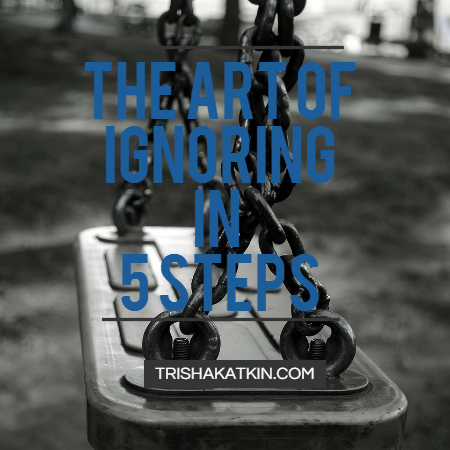
10 Ways to Support Students With Autism
Teach students with Autism?
Check!
Got challenging behavior?
Check!
What can I do?
Read on!
Why, hello there! I’m Trisha and I run a blog about reaching and teaching students with Autism. My main goal is to train teachers how to increase student engagement while teaching them strategies to decrease their own burnout.
Engaging a student with autism can be tough. The broad term “Autism” encompasses a whole spectrum of abilities and it’s important to note that although a strategy may work for one, it most certainly, won’t work for all. There’s a reason why people say, “If you’ve met one child with autism, you’ve met one child with autism.” Although every child is different, there seems to be one thing that rings true for all children with autism, Positivity! Using Positive Behavior Supports is a wonderful way to increase desirable behavior while simultaneously decreasing challenging behaviors.
- Pick Your Battles
Learn to ignore challenging behavior. To a degree…
Arguably, one of the hardest things to do, but most important. Pick your battles wisely. Inevitably, your student will have behaviors that are probably irritating, but not life threatening. Choose your battles. There is no need to get into a challenging power struggle with a student over something that is not hurting anyone. Unless the behavior is keeping another student from accessing a “Free and Appropriate” education, or it is hurting the student either physically or emotionally, there is probably no need to intervene.
If the behavior is clearly attention seeking and will not result in your student or a peer being injured, then ignore if possible. Chances are that these behaviors will lessen on their own.
- Make a Classroom Constitution!
Students with autism require clear expectations of the limits. Giving solid and concrete boundaries and limitations will help your students understand what is okay (and what is not okay) to do.
Preemptively setting ground rules will help clue your student. Just make sure to add pictures! Students with Autism think in pictures and are naturally very visual.
If possible, sit with your students and create a Classroom Constitution. Talk about ground rules and what is okay and not okay to do in class. Add pictures and voilà! Classroom Constitution!
If it is not possible to discuss the idea of ground rules and a Classroom Constitution, that’s okay too. Just simply create a bulletin board with the rules of your classroom and add pictures. Practice introducing the concepts during a discrete trial or individual session to pre-teach the concepts, then begin to generalize the ideas during other parts of the day.
- Listen to Your Student
Show your student respect and listen to him or her.
Now, I don’t necessarily mean have a heart-to-heart with your student, though that would be nice wouldn’t it? If our students could label and identify their feelings and tell us their needs and wants? But, unfortunately, our students have a difficult time understanding emotions. So, listen with a different kind of ear. Listen for the silent struggle. If your student is non-verbal, listen for the moan, groan, or cry that signals that your student is having a hard time. It’s important to decipher those vocalizations that tell you that your student is in distress. Show that you care, and respect your student’s feelings. Be the model to teach him or her the value and importance of understanding their emotions.
- Offer Options!
Coffee or tea? Vanilla or chocolate? Ketchup or mustard?
Choices make all the difference, don’t they?
Students with Autism want a choice, but need guidance. Free time is very difficult. Allowing your student to freely choose an activity is challenging for a few reasons. First he may not know how to play appropriately; or he just may have a hard time choosing from endless opportunities. It would be easy to choose from vanilla or chocolate; but does the ease of decision change if I offered you 31 flavors?
Sometimes, less is more.
Alleviate choice anxiety for your student by offering him 2 appropriate options for that given time period. If it is recess, maybe he could swing or play with the ball. If it is fine motor time and you are doing puzzles, offer him the option of one puzzle or the other. By offering choices you have given him a chance to be in control while you gain buy-in AND compliance into the activity you wish for them to complete. You have also allowed for him to be independent and make a good choice.
A great example in my classroom is during life skills time when the students are asked to brush their teeth. Many of my students have sensory difficulties with brushing their teeth, therefore, I end up having several challenging avoidance behaviors during this time. To alleviate part of the challenge I bought each student 2 different colored toothbrushes. That way, they always had a choice. “Do you want the red or blue toothbrush today?” That way the student understood that the expectation was to brush their teeth during this time every day, but at least had the choice of color and could choose independently.
Also, what a fabulous way to carry over color concepts from one setting to another!
Win-Win!
- Offer Breaks
Everyone needs breaks. Your students included. There have been several studies that have suggested that individuals need breaks in order to be more productive. Hello, 4-day work week! Many influential corporations such as Google and Lego implement smaller workweeks and more frequent vacations as they believe that time off sparks creativity.
If studies show that more breaks increase productivity in neurotypicals imagine the need for them in your classroom for your students where stimuli can be so overwhelming!
So, why not implement extra breaks into your students’ day? Take them as needed, schedule them in, make them a reward, just get them in there. Your student will thank you and you will get A LOT more work out of them.
- Use Clear, Concise, Positive Language
Okay, this is a BIG one. It’s vital for you to use simple, clear and concise language. Students with Autism have delayed language skills and require you to be direct and clear.
Say what you mean and mean what you say.
Do not add “fluff” to your sentences and avoid sarcasm. Try to use positive language as much as such as “safe hands,” or “quiet mouth.”
Definitely avoid using the phrase, “No, thank you,” as this phrase, although polite, is very confusing to students with Autism. Saying “No,” signals to a student that they should stop what they are doing, yet following it with “thank you,” indicates that they did something right and should continue. Choose your words wisely, frame it in a positive manner, be short, clear and direct and you will be golden!
- Give your Students a Paycheck!
Hello, paycheck! Let’s face it. We all work for some form of payment. Maybe it’s a paycheck at the end of the week or a glass of wine at the end of the day, whatever it is, it’s important to be rewarded for what you do. Your students feel the same way.
Students with Autism are all different. Reward frequently, and appropriately. Find what works and ride that wave for as long as it lasts. Need help finding the best reward system or discovering what your student will work for? Head on over to see me and sign up for my FREE ECourse, The 7-Step Social Story. I guarantee you’ll love it and you will be privy to all my future posts that will be diving deeper into all these topics. You will also be first in the know for when my Course, The Autism Quilt, opens for enrollment. Check it out here!
- Set-up for SUCCESS!
No one likes to be wrong. NO ONE. And your students are no different. In fact, many students with Autism have Obsessive Compulsive qualities that manifest in a variety of ways including hating to be wrong. Alleviate the stress of a potential meltdown by setting your student up for success in the first place. No, I don’t mean doing the work for him or giving him the answers to the test. I mean teaching for success. Set up Errorless Discrete Trial Training so that your student will succeed and feel proud of himself while he is learning. And again, if you need help, check me out! I got you covered! My future posts will cover just these topics. And you don’t want to miss out! Sign up here!
- Teach at Instructional Level
Okay, hopefully, this one seems obvious. It’s impossible to teach a kindergartener quantum physics so let’s not do that to our students. Teach at your student’s instructional level. Make sure that they are capable of understanding what you are trying to present to them BEFORE trying to present something to them.
Now, I know that this may present itself with a whole slew of problems. Common core and administrative control is breathing down your neck. I get it. But get creative!
ADAPT, ADAPT, ADAPT!
Take a lesson from the general education, or if you are self-contained, create one with common core goals in mind, but taught at your students’ level.
- Validate Feelings
Yup, it’s #10 on the list, but doesn’t change its importance. Validate your student’s feelings. Even if it seems irrational to you that your student is upset because he dropped a bit of jelly in his lap, or someone said the wrong phrasing of words, it is still their feelings. It doesn’t have to make sense to you, it does to them and that’s all that matters. This goes along with #3, but takes it a step further. Your student needs to FEEL heard. If they are upset and want to talk or cry or yell (as long as they and others are safe,) let them. It’s important that your student drain off their emotions and feel genuinely heard. There is not much worse than being really upset and feeling like no one is listening. So sit back and try not to say anything. If your student if really upset, allow them to just vent. Don’t offer solutions, don’t get into a fight, just allow them to get it out however they can. You can always process the whole incident that set them off at a later time when they have calmed down. That is when you can discuss what happened and solutions for next time. It’s when your student is calm that the true healing can begin.
You Rock!
XO,
Trisha Katkin
If you enjoyed this post, please visit me here, and share with your friends! If you really liked the post, let me know! Zip me an email at theautismquilt@gmail.com, and if you REALLY REALLY like me, let’s join forces! Follow me on Twitter @TRISHAKATKIN, Pinterest, or Facebook. I would love to connect!
Thanks!


